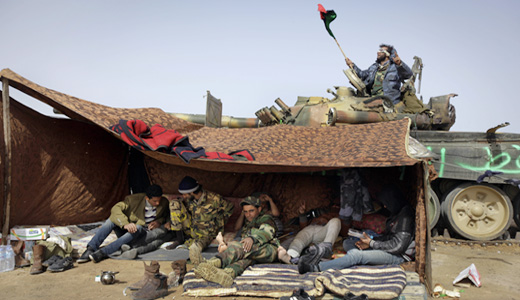
There were two images from the Libyan war that are likely to spell real trouble in the coming years. One was of several U.S. A-10 attack planes, ungainly looking machines ugly enough to be nick named “Warthogs,” taxing down a runway. The other was of several rebel fighters dancing on top of a burning tank.
That tank, an old Russian-era T-72, was likely knocked out by one of those A-10s, which means those rebels fighters are almost certainly going to be in a world of hurt. Because, while they were celebrating, they were also breathing in the residue from the shell that killed that tank, a 30 mm depleted uranium munition (DUA).
DUA is the weapon of choice when it comes to killing armored vehicles, and A-10s are specialists at using it. The U.S. used 320 tons of it in the first Gulf War, 10 tons in Kosovo, and over 1,000 tons in the invasion of Iraq. It is lethal to tanks, but it also damages anything that comes into contact with it. Common photos back in 1991 were of U.S. soldiers climbing on top of knocked out Iraqi tanks to have their pictures taken or to look for souvenirs. When they did, they inhaled uranium oxide or impregnated their uniforms with it.
The soldiers didn’t know better because the U.S. Defense Department (DOA) told them DUA was harmless, even though the DOA knew better. In 1991 the U.S. Army’s Armament Munitions and Chemical Command concluded that “any system struck by DUA penetrator can be assumed to be contaminated with DU,” and instructed soldiers to wear protective masks, clothes and respirators “as a minimum,” and dispose of the clothing afterwards.
The only problem was that the Army never told the troops, even those whose job it was to deal with vehicles hit by DUA. No one said a word to the 144th National Guard Supply Company of the 24th Infantry Division who picked up 29 U.S. armored vehicles hit by DUA “friendly fire” to ship them home. When the tanks and armored personnel carriers arrived in South Carolina, they were interned in a radioactive waste dump. If the soldiers didn’t know the objects were “hot,” the brass did.
Many of those members of that National Guard company subsequently came down with the “Gulf War Syndrome” (GWS) that afflicted at least 118,000 out of the 700,000 soldiers who served in the 1990-91 conflict. Veterans suffer from chronic fatigue, headaches, muscle spasms, joint pains, memory loss, anxiety and balance problems, were twice as likely to develop amyotrophic lateral sclerosis (Lou Gehrig Disease), and between two and three times more likely to have children with birth defects.
DUA is one of the most deadly anti-tank weapons around. The enormous weight of the DUA “arrow” in each shell can penetrate four inches of armor as if it were margarine. It then explodes in a 10,000-degree fireball that reduces up 70 percent of the munition to powder. The powder can travel up to 25 miles from the initial blast site.
Depleted uranium is not highly radioactive, but it has a half-life of 4.4 billion years, and, if it gets into your system, it can be very dangerous. According to the U.S. Environmental Policy Institute, DUA “has the potential to generate significant medical consequences.”
“People have always assumed low doses are not much of a problem,” Alexander Miller of the U.S. Armed Forces Radiobiology Research Institute told the Guardian (British), “but they can cause more damage than people think.” A study by the Institute found that DUA could damage bone marrow chromosomes.
Not all of the Gulf War butcher bill can be laid at the feet of DUA. After 11 years of denying there was anything to GWS, the Pentagon finally admitted that at least 130,000 soldiers had been exposed to chemical weapon residue when the Iraqi arms depot at Kamisiyah was blown up. Modern battlefields tend to be toxic nightmares, and that was doubly so in Iraq.
But there is no question that DUA was a major contributor to the syndrome, particularly for those who developed immune related diseases. A standard effect of radiation is suppression of the immune system.
The effects of low-level radiation are hard to track, because many “hard” cancers take 16 to 24 years to develop. Iraqi medical authorities claim that the cancer rate in Basra-an area that was saturated with DUA in the Gulf war and the Iraq War-has jumped ten fold, and birth defects are much higher than in the rest of the country.
DUA is also used in 25 mm cannon shells, and 105 MM and 120 MM tank shells. The Army is using it to manufacture 50-caliber machine gun ammunition and is experimenting with using it for standard issue infantry weapons. It is also used to coat armored vehicles, making them almost impervious to non-DUA shells.
The U.S. is selling DUA to Israel, Egypt, Pakistan, some of our NATO allies-Germany and Italy won’t use it-Sweden, Taiwan, Saudi Arabia, Pakistan, Thailand, and other countries that the Pentagon will not reveal in the name of “national security.”
Depleted uranium is also a highly toxic metal and can damage the liver and kidneys, particularly if it gets into the water supply. If a DUA round misses a target, its “penetrators” are so heavy that they tend to go deep into the soil. “A major concern of the potential environmental effects of intact [DUA] penetrators or large penetrator fragments,” notes the World Health Organization, “is the potential contamination of ground water after weathering.”
Because of the dangers associated with DUA, in August 2002 a subcommittee of the United Nations found that the weapons violated seven international agreements, including the UN Charter and the Geneva Conventions. Efforts to ban it, however, have been vetoed by the U.S., France and Britain. In 2009 Belgium became the first country to ban the use of DUA, and in the same year the Latin American Parliament voted for a moratorium on its use.
The International Coalition to Ban Uranium Weapons that includes 120 non-governmental organizations is currently lobbying to get the weapons eliminated.
There are other rough beasts being visited on the Libyans these days as well, including cluster weapons, highly explosive canisters that can shred everything from people to tanks. U.S. warplanes have been dropping CBU-103, 104, 105, and AGM-154 A and B, all of which have a failure rate of anywhere from 5 to 23 percent. These unexploded “bomblets” can kill for decades.
During the bombing of Laos from 1964 to 1973, 90 million cluster munitions were dropped, killing more than 12,000 civilians. The bomblets continue exact a yearly toll of 100 to 200 people. More than 50 million clusters were dropped during the 1991 Gulf War, and in the two years that followed the war’s end, they killed 1,400 Kuwaiti citizens. A U.S. company hired to clear cluster weapons from a small area in Kuwait found 95,700 unexploded MK-118 submunitions from the notoriously unreliable CBU-99 “Rockeye” cluster bomb.
Unexploded clusters are still causing problems in Kosovo, and they take a steady toll of civilians in Afghanistan.
Libya has no-go areas dating back to the Second World War, when Italians, Germans and British seeded their fronts with land mines. Whatever government emerges in Libya today will have to deal with the aftermath of yet another war, this time created by DUA and cluster weapons. “The problem in defense is how far you can go without destroying from within what you are trying to defend from without,” Dwight Eisenhower once remarked.
A problem indeed. One hopes Libya manages to avoid what a village in Vietnam experienced, the one that was destroyed in order to save it.
Photo: Libyan rebel fighters resting in the shade under a tent attached to a destroyed tank of Gadhafi’s forces, at the western gate of Ajdabiya, Libya, April 6. They are probably endangering their lives by breathing in the residue from the shell that destroyed the tank, a 30 mm DUA. (Ben Curtis/AP)










